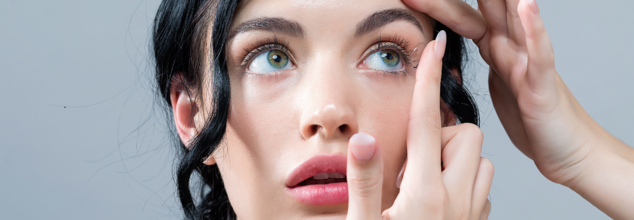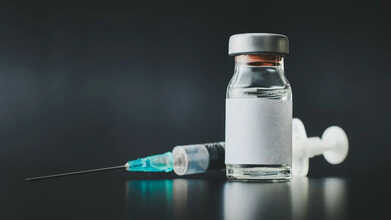- Health Conditions A-Z
- Health & Wellness
- Nutrition
- Fitness
- Health News
- Ayurveda
- Videos
- Medicine A-Z
- Parenting
Swimming With Contact Lenses Causes A Woman To Go Blind In One Eye, 5 Safety Measures For Contact Lenses

Contact Lens Safety (Credit- Canva)
A 23-year-old woman's life took a devastating turn after a seemingly harmless swim. Brooklyn McCasland contracted a rare parasite infection, acanthamoeba keratitis (AK), while swimming with her contact lenses on. This microscopic amoeba can cause severe damage to the cornea, leading to vision loss. This infection acts like other common infections and thus Ms. McCasland was placed on steroids and a few other drops. But there was still a delay in the treatment causing her issues to get worse and the pain growing. She exclaimed that she was in the most pain she had ever experienced which eventually was followed by her losing her vision in the right eye.
Delayed Diagnosis and Worsening Conditions
Once diagnosed, McCasland was immediately started on a specialized treatment regimen. However, due to the rarity of the infection, the necessary medication had to be sourced from the UK. Despite the aggressive treatment, her recovery is uncertain. Doctors have warned her that she may require a cornea transplant to restore her vision. The doctors luckily had a few sample drops of the medicine she needed so she started on them while they imported more from the US. She had to apply these every 30 minutes and understands that this is a slow process. Ms. McCasland says that she is thankful that the doctors knew exactly what the infection was so that she got the treatment she needed, she also adds that she would’ve never gone swimming with contact lenses had she known what the consequences could’ve been.
Acanthamoeba keratitis is a serious but preventable condition. By following proper contact lens hygiene practices, individuals can significantly reduce their risk of infection. It is crucial to avoid wearing contact lenses while swimming or showering and to clean and store them correctly.
McCasland's unfortunate experience serves as a powerful reminder of the importance of these precautions. By sharing her story, she hopes to raise awareness and prevent others from suffering a similar fate.
Contact Lens Safety Measures
Eyes are really sensitive and need to be dealt with delicately especially when it comes to contact lenses. Here are some safety measures you should practice with them. In case you feel any irritation or pain in your eyes please visit the emergency health facility closest to you without delay.
Replace Your Lens Case Regularly
A common mistake among contact lens wearers is neglecting to replace their lens case regularly. Even with proper cleaning, cases can accumulate harmful germs over time. These germs can lead to serious eye infections when they come into contact with your eyes.
Avoid Sleeping or Napping in Your Contacts:
Sleeping in contact lenses significantly increases your risk of developing eye infections. This can lead to microbial keratitis, a painful condition that can cause inflammation of the cornea and, in severe cases, permanent vision loss or blindness.
Don't Swim or Shower in Your Contact Lenses:
Waterborne germs can easily attach to your contact lenses and infect your eyes. Wearing contacts while swimming or showering can put you at risk for Acanthamoeba keratitis, a serious eye infection caused by an amoeba commonly found in water. These infections can be extremely painful and difficult to treat.
Wash Your Hands Before Handling Your Contacts:
Germs on your hands can transfer to your contact lenses and lens case. To minimize the risk of infection, always wash your hands thoroughly with soap and water before touching your contacts.
Schedule Regular Eye Exams
Annual eye exams are essential for maintaining healthy contact lens wear. Your eye doctor can assess your eye health, identify any potential issues, and provide guidance on proper contact lens care.
You're Breathing Your Way Into Diabetes

AIIMS Study Finds No Evidence Linking COVID-19 Vaccination To Sudden Deaths In Young Adults

Credits: Canva
There has been a long-running belief that COVID-19 vaccines are behind sudden deaths in young adults. Posts circulating on social media and unverified online claims have repeatedly linked vaccination to sudden collapses, heart attacks, or unexpected deaths, particularly among people aged 18 to 45 who seemed otherwise healthy.
These claims have caused anxiety among families, despite the absence of solid scientific backing. A new study published by AIIMS now brings much-needed clarity on whether COVID vaccines have any connection to sudden deaths in young adults.
Also Read: Can Overusing Air Purifiers Harm Your Lungs? Expert Explains
AIIMS Study Finds No Link Between Covid Vaccination And Sudden Deaths In Adults
Worries around sudden deaths in young adults have increased in recent years, especially in the period following the COVID-19 pandemic. Speculation blaming COVID vaccines gained traction across platforms, adding to public concern. However, fresh findings from a study carried out by the All India Institute of Medical Sciences (AIIMS), New Delhi, offer a clear answer. After examining detailed autopsy reports, researchers concluded that underlying heart disease, and not COVID-19 vaccination, is the leading cause of sudden deaths in younger individuals.
Heart Problems Leading Cause Among Deaths In Young People
The AIIMS study found that heart-related conditions were responsible for 42.6 per cent of sudden deaths among people aged 18 to 45 years. Within this group, heart attacks accounted for nearly 85 per cent of cardiac-related deaths. Other contributing factors included structural abnormalities of the heart, congenital defects, and inflammation of the heart muscle. Respiratory illnesses made up around 21.3 per cent of sudden deaths, with choking, pneumonia, and tuberculosis emerging as the main causes. In close to one-fifth of the cases, doctors were unable to determine the exact cause of death.
No Evidence Linking Deaths To Covid Or Vaccines
Crucially, the researchers observed no meaningful rise in sudden deaths among individuals who had previously contracted COVID-19 or received the vaccine. Of the cases analysed, only 4.3 per cent had a history of COVID infection, while 82.8 per cent had been vaccinated. Dr Sudheer Arava, Professor of Pathology at AIIMS, explained that the year-long study reviewed nearly 100 cases and found no signs of vaccine-related complications, with just one instance of myocarditis reported. The findings also pointed to differences across age groups.
Among those aged 46 to 65, nearly three-quarters of sudden deaths were linked to heart disease, while unexplained deaths were far fewer. Notably, the proportion of women among sudden deaths was higher in the younger age group than among older adults. The study carries weight as it directly challenges claims blaming COVID-19 vaccines for sudden deaths.
Doctors emphasise that lifestyle-related issues such as unhealthy eating habits, lack of physical activity, and chronic stress continue to play a major role in heart disease among younger people. This, they say, highlights the importance of early prevention and regular health screenings. Dr Arava also urged the public to rely on credible scientific information and steer clear of misinformation that could erode trust in proven public health measures, including vaccination.
Lancet Study Estimates 15 Lakh Annual Air Pollution Deaths in India; Centre Calls Data 'Inconclusive'

Data by aqi.in
zDelhi woke up again to a yet another thick smoggy morning, with visibility dropping low. On Monday morning, the city's average air quality index or AQI stood at 'severe' category for the third consecutive day. As of 6am, the data from the Air Quality Early Warning System for Delhi stood at 457. As per the Central Pollution Control Board (CPCB), at least four stations, including Ashok Vihar, Jahangirpuri, Rohini, Wazirpur, recorded AQI of 500 at 7am.
As of 10am on Monday morning, Delhi stood at 480, Noida at 551, Greater Noida at 568, Gurugram at 454, Faridabad at 546, and Ghaziabad at 569, all under 'severe' category.
As a result, the Commission for Air Quality Management has issued directives to Delhi and NCR state governments on Sunday, December 14. The directives suggest for an immediate halt on all outdoor physical sports activity. This move has come after concerns were raised around schools that are still continuing outdoor activities despite poor air quality.
Amid this, a Lancet study also revealed that 15 lakh annual deaths in India are due to long-term exposure to air pollution. The particulate matter or PM2.5 found in air pollution is linked to many health issues. Since the particles are so small in size, it could easily penetrate deep into the lungs and enter the bloodstream, and cause serious health impacts. However, despite the global studies highlighting the country's ever-growing pollution problem, the Centre stated that "there is no conclusive data available in the country to establish direct correlation if death/disease exclusively due to air pollution."
What Does The Lancet Study Say About Air Pollution And Health?
The comprehensive Lancet study conducted an analysis from 2009 to 2019, and measured the consequence of long-term exposure to fine particulate matter or PM2.5.
The study estimated: “1·5 million deaths occurred annually due to long-term exposure to PM2·5 in India every year in excess of the 5 μg/m3 that is recommended by the WHO ambient air quality guidelines.”
The study noted that every 10μg/m³ increase in annual PM2·5 concentration was associated with an 8.6 pc higher risk of all-cause mortality.
Using India’s National Ambient Air Quality Standards, researchers estimate that about 3.8 million deaths between 2009 and 2019 were linked to PM2.5 exposure. When WHO guidelines were applied, the number rose sharply to 16.6 million, nearly one-fourth of all deaths in the country. The analysis relied on advanced causal methods and high-resolution models that mapped district-level PM2.5 exposure across India, while accounting for factors such as socioeconomic status, age distribution, and indoor air pollution.
These findings are backed by a 2017 time-series study from Delhi that examined the short-term impact of air pollution on deaths from natural causes. The researchers pointed out that studies worldwide have consistently shown a clear link between common urban air pollutants and harmful health effects. Despite Delhi’s well-documented air quality crisis, they noted that limited local evidence on how specific pollutants affect health had long slowed meaningful policy action.
Different Pollutants Impact Different Age Groups
To bridge this gap, the study analyzed data from 2008 to 2010, focusing on key pollutants: particulate matter under 10 micrometres (PM10), sulphur dioxide (SO2), nitrogen dioxide (NO2), carbon monoxide (CO), and ozone (O3). Using a semi-parametric regression model that adjusted for non-linear factors such as time trends, temperature, and humidity, the researchers found strong links between short-term exposure to both particulate and gaseous pollutants and daily all-cause mortality.
They estimated that every 10 μg/m³ rise in PM10 levels was associated with a 0.14 per cent increase in all-cause deaths. Among gaseous pollutants, NO2 had the strongest impact, with a 1 per cent rise in mortality for every 10 μg/m³ increase in daily concentration. Ozone and carbon monoxide also showed significant effects, even after accounting for NO2 levels. The analysis that was done based on age also revealed that particulate matter affected older adults aged 65 and above. Whereas, gaseous pollutants had a greater impact on people aged 5 to 44.
Overall, the researchers concluded that the evidence clearly reinforces the link between poor ambient air quality and increased all-cause mortality.
© 2024 Bennett, Coleman & Company Limited

